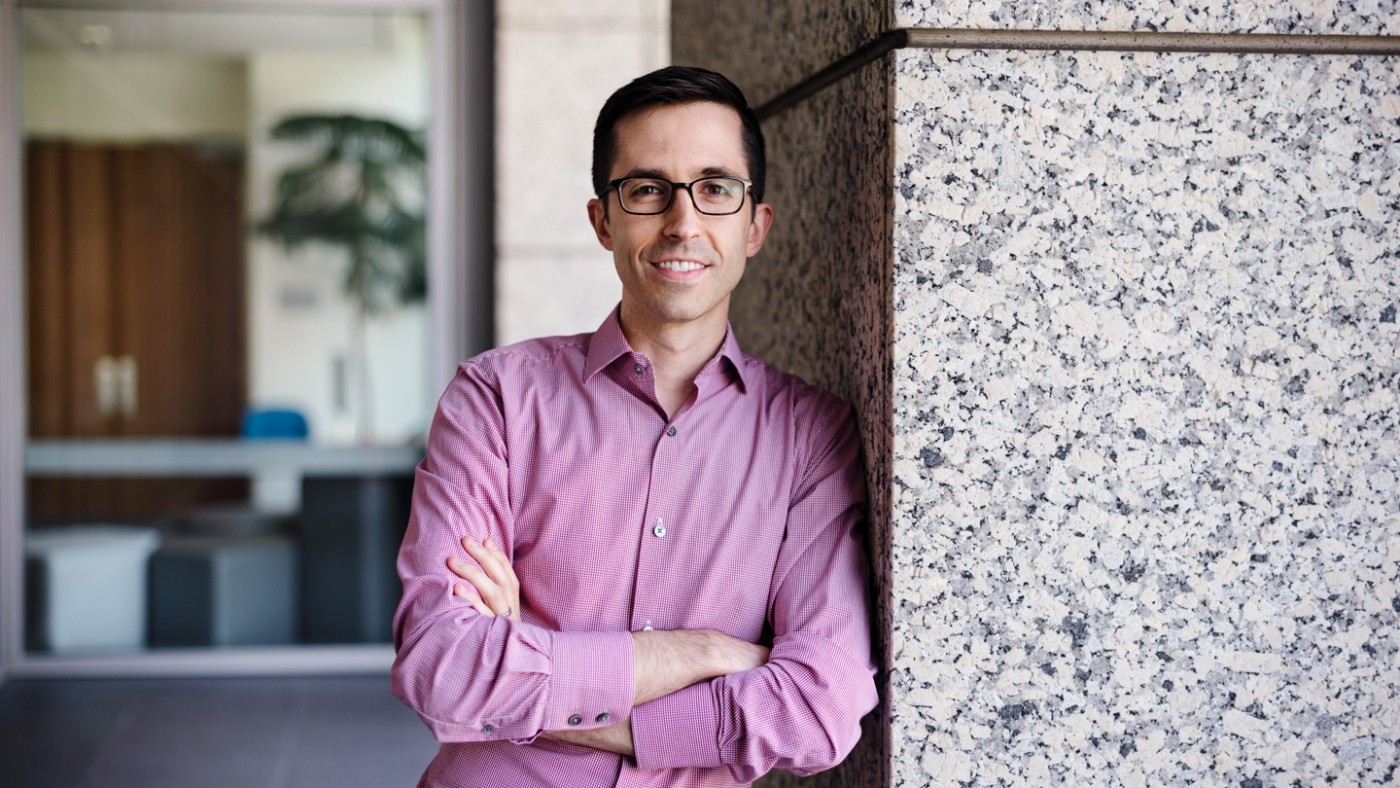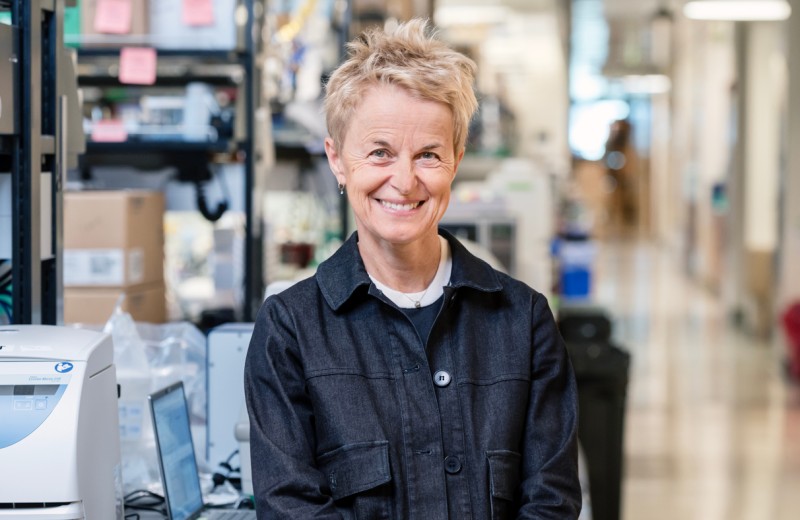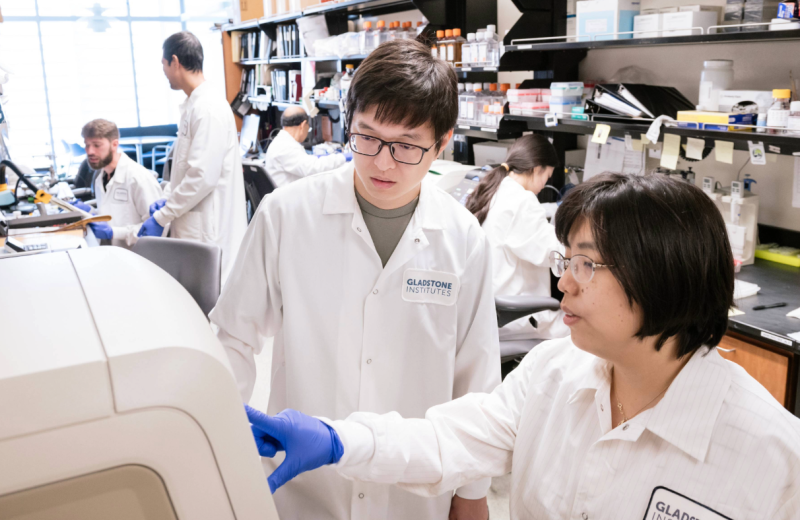Gladstone NOW: The Campaign Join Us on the Journey✕

Ryan Corces is joining the Gladstone Institute of Neurological Disease and the Gladstone Institute of Data Science and Biotechnology.
The top candidate from a highly competitive search, Ryan Corces, PhD, was selected to join Gladstone Institutes as an assistant investigator. His new lab will focus on studying how genetic and environmental factors can impact the risk of developing neurodegenerative diseases.
Corces is joining the Gladstone Institute of Neurological Disease and the Gladstone Institute of Data Science and Biotechnology.
“Ryan is a wonderfully accomplished scientist and I am thrilled that he is joining our team,” says Lennart Mucke, MD, director of the Gladstone Institute of Neurological Disease. “He has an extraordinary set of capabilities that is becoming increasingly important in biomedical research. His leading-edge approach has the potential to transform brain research, particularly with respect to identifying and understanding factors that determine risk for or resistance to Alzheimer’s and Parkinson’s disease.”
He will also be appointed as assistant professor in the Department of Neurology at UC San Francisco (UCSF). “We are delighted that Ryan has decided to bring his considerable talents to our department; this will add to our terrific collaborations with Gladstone Institutes,” says S. Andrew Josephson, MD, chair of UCSF’s Department of Neurology.
Having studied molecular biology and computer science during his undergraduate degree at Princeton University, followed by cancer biology and epigenetics throughout his graduate and postdoctoral studies at Stanford University, Corces is one of the few scientists who can tackle complex research on disease development and also perform his own rigorous analysis of large data sets. This rare skill set has prepared him for a career at the intersection of neurodegenerative research and computational biology.
“I’m very excited to join this top tier research institution,” says Corces. “Gladstone has such phenomenal and diverse science. In a relatively small academic environment, you can find an expert within the building on pretty much everything. I can already see numerous opportunities to collaborate with my new colleagues to increase the impact of our research.”
“Gladstone is also exquisitely well-organized,” he adds. “I’ve been so impressed that everyone I interacted with, at all levels within the organization, showed me they truly care about what they’re doing. It’s pretty unique, and I can’t say that I’ve experienced that in many other places.”
Uncovering How Environmental Factors Lead to Alzheimer’s Disease
All cells in the human body—from blood cells to brain cells—have the same DNA or genetic code. Yet, they can perform different functions based on how they interpret this code. To act in unique ways, each cell only turns on a fraction of its genes, while leaving the rest turned off.
External, non-genetic factors can also influence which genes are turned on or off, without changing the genetic code itself. This is known as epigenetics.
“If you think of the genetic code as a language made up of words, epigenetics would be the accent marks on words that result in different pronunciations and meanings,” explains Corces. “While genetic mutations modify genes directly, non-genetic factors, such as previous illnesses, exposure to pollutants, diet, or aging, can leave lasting imprints on cell function.”
So, lived experiences—what you choose to eat, the things you do, the environment in which you live, how stimulated your brain is on a daily basis—might all predispose or prevent you from developing a disease.
A classic example is how bisphenol A (BPA) in plastic water bottles was shown to have epigenetic effects on fetal brain development. Or, how some evidence suggests that regular physical exercise might help keep your mind sharp as you age.
“Given that both genetic and non-genetic factors contribute to our propensity to develop disease, the goal in our lab is to use epigenetics to understand the difference between these components and how they interact to cause disease, specifically Alzheimer’s and Parkinson’s,” says Corces.
Based on genetic markers, some people would be considered to have a higher predisposition to Alzheimer’s, yet they never develop the disease. Inversely, some people with a very low genetic predisposition can still develop Alzheimer’s. Also, both Alzheimer’s and Parkinson’s are age-related diseases, with most patients manifesting symptoms after age 70. These facts suggest that, in addition to the known genetic causes of neurodegeneration, non-genetic factors must also be at play.
“If these diseases were purely genetic, they would likely manifest much earlier in life,” says Corces. “So, there’s a huge component of neurodegenerative diseases that we still don’t quite understand and, in my opinion, studying epigenetics has the potential to provide key insights to develop novel therapies.”
As he launches his lab, Corces will focus on identifying the epigenetic factors that may contribute to making someone particularly resistant or vulnerable to Alzheimer’s disease. To do so, his team uses human-derived tissue, collected post-mortem from patients dedicated to helping research.
“These tissues are invaluable to our work,” he explains. “While it is inherently more challenging to uncover biology in such complex human tissues, we believe that what we discover from carefully controlled studies should be directly applicable to the disease because we’re studying it in its correct context.”
Of course, his group also validates findings from human tissue samples in either cultured cells or animal models. “That’s why Gladstone is a really amazing place for me to be, because so many researchers are doing elegant mouse modeling experiments and using human stem cell–derived brain cells, both of which we can use to recapitulate our results from human tissue.”
A Career Switch to Tackle the Next Scientific Frontier
Aside from a few undergraduate research experiences in aging, memory, and cognition, most of Corces’s early scientific career focused on cancer, from leukemia to solid tumors. His PhD, in the laboratory of Ravindra Majeti, MD, PhD, initiated him to the importance of human disease research, while his postdoctoral work, in the laboratory of Howard Y. Chang, MD, PhD, provided his foundational training in epigenetics.
However, it was a collaboration with Thomas Montine, MD, PhD, chair of the Department of Pathology at Stanford, that redirected him toward neurodegenerative disease research.
“Tom spent hours teaching me about the brain and neurodegeneration,” says Corces. “I would count him as one of the most influential mentors in my 18-year scientific career. He single-handedly converted me into a neurodegeneration researcher and changed my scientific trajectory.”
The other reason Corces jumped so quickly into studying neurodegeneration was to tackle the next scientific frontier. No therapies exist to prevent, stop, or cure Alzheimer’s or Parkinson’s disease—this marks one of the greatest unmet clinical needs of our time, and a looming global public health crisis.
“We have very good fundamental knowledge of what causes cancer, and we just don’t quite have that understanding in neurodegenerative diseases,” says Corces. “I think I can make a difference scientifically by studying Alzheimer’s, which is what really pushed me to dedicate the rest of my life to understanding this disease.”
As for science in more general terms, it seems Corces may have been predestined for the field from birth. Both his parents are biologists; his mother was a professor and vice provost of Emory University, and his father is a professor of epigenetics at the same university.
“I guess it’s both a genetic and epigenetic component that has pushed me to study this field,” Corces jokes.
“My upbringing and my parents’ support have made a huge difference in opening this path for me at a very young age and in how I have grown as a scientist,” he adds. “It also doesn’t hurt that they knew how to navigate every roadblock that you face in this career. They were always there to provide advice, give me feedback, or even read a grant application.”
So now, following in his parents’ footsteps, Corces is opening his own lab.
Corces carries on his shoulders a great sense of responsibility toward the patients who donate the tissues that enable his research. He and his team will work hard to unravel the science behind what makes certain people susceptible or resilient to Alzheimer’s disease, with the ultimate goal of contributing to therapies that will have a lasting impact on patient health and patient survival.
“I think Gladstone is the perfect place for that type of translational research,” Corces explains. “It’s a truly unique scientific environment, located right across the street from UCSF’s Mission Bay campus and so close to other academic partners and start-up companies. And Gladstone makes it easy for scientists to transition their academic research toward the clinic.”
“Ryan’s expertise fills a unique niche here at Gladstone that will affect many laboratories, and his focus on human disease complements our other talented researchers,” says Gladstone President Deepak Srivastava, MD. “His substantive achievements are impressive at this early stage in his career. He has a promising future in science and biomedicine as an innovative and impactful investigator.”
“I know that being a scientist is the only career that will make me happy for the rest of my life,” says Corces. “Despite the challenges and strenuous work, I think being a successful scientist is an extremely rewarding experience. You get to mentor the next generation of researchers. You get to have constant innovation in your life. And you have an opportunity to help improve peoples’ lives. What more could you ask for?”
For Media
Julie Langelier
Associate Director, Communications
415.734.5000
Email
About Gladstone Institutes
Gladstone Institutes is an independent, nonprofit life science research organization that uses visionary science and technology to overcome disease. Established in 1979, it is located in the epicenter of biomedical and technological innovation, in the Mission Bay neighborhood of San Francisco. Gladstone has created a research model that disrupts how science is done, funds big ideas, and attracts the brightest minds.
About Ryan Corces
Ryan Corces is an assistant investigator at Gladstone Institutes, and an assistant professor of neurology at UC San Francisco (UCSF). He received his bachelor’s degree in molecular biology from Princeton University, and his PhD in cancer biology from Stanford University. During his postdoctoral training at Stanford, under the mentorship of Howard Chang and Thomas Montine, he focused on dissecting epigenomic dysregulation in cancer and neurodegenerative disease. Corces’s work has generated atlases of the epigenomes of leukemia cells and brain cells, and paves the way to identify novel therapeutic interventions that target the intersection of genetic and epigenetic determinants of disease. His presentations have been prized at many symposiums, and he is the recipient of many awards and fellowships, most recently a K99 award from the National Institutes of Health and a Scholars Award from the American Society of Hematology.
About the Search Committee
The joint Gladstone-UCSF search committee that identified Ryan Corces as the top candidate for this recruitment was chaired by Katerina Akassoglou. Other members included Lennart Mucke, Melanie Ott, and Katie Pollard from Gladstone, as well as Anna Molofsky, Jeremy Willsey, and Michael Wilson from UCSF.
Want to Join the Team?
Our people are our most important asset. We offer a wide array of career opportunities both in our administrative offices and in our labs.
Explore CareersBeyond Viruses: Expanding the Fight Against Infectious Diseases
Beyond Viruses: Expanding the Fight Against Infectious Diseases
The newly renamed Gladstone Infectious Disease Institute broadens its mission to address global health threats ranging from antibiotic resistance to infections that cause chronic diseases.
Institutional News News Release Cancer COVID-19 Hepatitis C HIV/AIDS Zika Virus Infectious DiseaseFueling Discovery at the Frontiers of Neuroscience: The NOMIS-Gladstone Fellowship Program
Fueling Discovery at the Frontiers of Neuroscience: The NOMIS-Gladstone Fellowship Program
The NOMIS-Gladstone Fellowship Program empowers early-career scientists to push the boundaries of neuroscience and unlock the brain’s deepest mysteries.
Institutional News Neurological Disease Mucke Lab NOMISGladstone Mourns the Loss of Founding Trustee Richard D. Jones
Gladstone Mourns the Loss of Founding Trustee Richard D. Jones
Jones lent Gladstone his time and expertise for nearly 50 years.
History Institutional News



